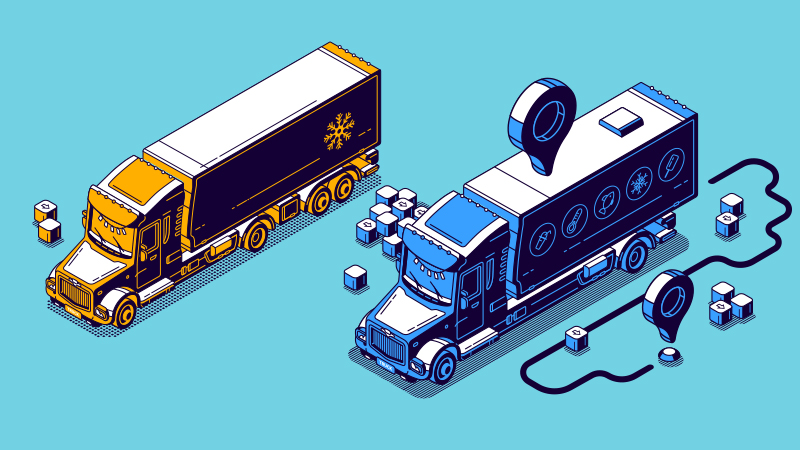
Category Scan: Cold Chain Logistics Market


Cold chain logistics is one of the most important sectors of logistics after COVID-19. Cold chain logistics provides services for different sectors such as food and beverages, FMCG, pharma, and healthcare. The global cold chain market size is estimated to be valued at $240.8 billion in 2021 and projected to reach $585.3 billion by 2026, recording a CAGR of 10–14 percent.

Demand drivers for Cold chain in 2022
The pharma and food sectors are two of the most important sectors driving cold chain logistics supply and demand globally.
- In the pharma sector, clinical trial logistics has emerged as the most demanding division; the demand here is based on the number of trials being initiated and the rapidness in movement of trials from initial Phase I and II to larger Phase III programs. Creating a port-to-patient approach to maintain the effectiveness of the COVID vaccines is then crucial.
- In the food sector, it is the last mile delivery of perishables, which has given rise to compact and hand-carried cold storage devices.
Key Market Trends in Cold Chain logistics
Some of the latest trends in cold chains across the globe are digitization of operations, sustainable packaging, and energy efficiency improvements within the warehouse.
Improving Energy Efficiency within the Warehouse to Reduce the Overall Warehousing Cost
-
Doors that are easy and quick to close and repair will be a good addition to the insulated warehouse by decreasing energy losses.
-
Use of recycled materials like steel and wood will make the building more carbon neutral.
-
Occupancy sensors can be installed at regular intervals to cut lighting energy by up to 75 percent.
-
Installing building maintenance systems to carefully monitor the temperature.
IoT in Cold Chain Logistics
-
Sensors in cold chain logistics are used to reduce wastage caused by improper temperature or environment provided for the products.
-
Track the temperature of stored drugs in transit to ensure they remain stable and within acceptable ranges.
-
2-D bar codes, RFID tags, and NFC sensors for drug and vaccines packaging are used to collect the required data.
-
Sensors can be programed to automatically signal alerts if vaccine storage moves outside a specified temperature range.
-
These advanced technologies have given rise to smart food logistics.
Block Chain Technology in Cold Chain Logistics
-
The food industry is expected to use block chain technology along its supply chains sooner than before, due to its advantage of improved transparency, which became a concern during the pandemic.
-
A unique identifier or an encrypted code is assigned to food at the start of the cold chain. This code serves as the base, which can provide various information such as routes taken and handling conditions, which will give an alert in case of a lack of adherence to protocol.
Innovative Packaging
-
Suppliers and organizations are currently more focused on sustainable packaging of products, foods, and other perishables.
-
The latest technology in place in cold chain packaging is new refrigerated shipping systems that do not require gel coolants and that weigh much less than typical cold chain packages. These systems use evaporative, reactive cooling technology that responds and adjusts to fluctuating temperatures.
COVID Impact in 2021 and Outlook for 2022
|
COVID Impact and Outlook |
Supply–Demand Gap |
Rental Price |
Labor gap |
Outlook for 2022 |
|
North America |
Supply is limited and demand is expected to increase, hence the gap will increase by 7 percent |
Expected to increase by 5–7% |
Expected to increase by 10–12% |
One of the major industries that impacted the cold chain in NA in 2021 and will impact it in 2022 is the food industry due to the increased import of perishables from the South American, East Asian, and European countries. |
|
APAC |
The supply is expected to increase from the start of 2022 and demand for the last mile delivery of perishables will also show an increasing trend |
Expected to increase by 4–6% |
Expected to increase by 15–20% |
E-commerce and vaccine supply will be the major driving factors in 2022 due to increases in demand for last mile delivery of fresh foods, and reefer transportation is also expected to rise because of rising concerns for the quality of foods in supermarkets. |
|
Europe |
Europe is expected to face a huge demand for space due to a space crunch in small countries |
Expected to increase by 7–8% |
Expected to increase by 10–15% |
Due to increasing health concerns across the EU and along with the rising COVID cases, it is expected that there will be demand for more clinical trials, and demand from the pharma sector will have an impact in 2022 as well. |
|
Rest of the World |
Demand for cold storage space for the pharma sector and processed foods will be driving the rental price in Latin America for 2022 |
Expected to increase by 2–5% |
Expected to increase by 20–25% |
LATAM and MEA are also fast-growing markets, for which at least 10–12 percent CAGR is forecasted as the expected growth in the next five years. Improving the technologies available and government intervention to improve the infrastructure are some of the key trends that are expected to happen in 2022 |
Recommended Reads:
Related Insights:
View All
Get more stories like this
Subscirbe for more news,updates and insights from Beroe






